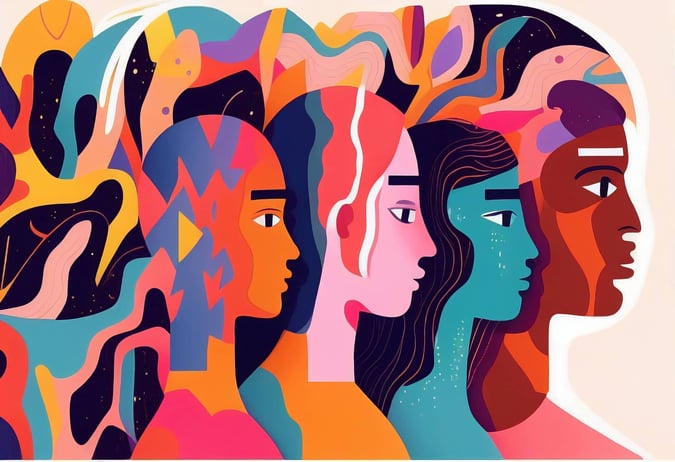In a society that values conformity and uniformity, neurodiversity is often overlooked. However, as more people acknowledge the importance of embracing and celebrating the unique wiring of each individual's brain, change is happening. It's essential to recognize that every person's thought process is distinct not only due to life experiences and culture but also because of their brain's unique functioning.
The traditional view of neurodivergent individuals as having deficits and impairments is being replaced by a celebration of their unique strengths and abilities. This shift from the "medical model" to the "social model" encourages individuals with neurological differences to embrace their high-functioning abilities and use them to contribute to society. Rather than attempting to mold each individual into the same academic and work environment, neurodiversity encourages us to embrace diversity and create a world where everyone can showcase their strengths, shine, and uncover their distinct talents.
Neurodiversity is crucial not only for personal well-being but also for societal progress. It inspires us to break free from labels and prejudices and instead recognize the unique strengths and potential of every individual. By challenging conventional ideas of intelligence, productivity, and normalcy, neurodiversity promotes a culture of creativity, innovation, and progress. Therefore, it must be nurtured, encouraged, and safeguarded to ensure that our society thrives by embracing diversity in all its forms.
What is Neurodiversity?
Judy Singer, an Australian sociologist who is herself on the autism spectrum, coined the term "neurodiversity" in the late 1990s to redefine the conversation around conditions such as Autism, Tourette Syndrome, Dyslexia, Developmental Coordination Disorder, and Nonverbal Learning Disability. She aimed to move away from the traditional narrative of deficits, disorders, and impairments and instead celebrate the unique strengths and differences of neurodivergent individuals.
Neurodiversity is a paradigm that acknowledges the diversity of brain conditions as normal variations in the human genome. Unlike the traditional view of neurological differences as pathological, neurodiversity asserts that these differences should be respected and celebrated as a social category on par with gender, ethnicity, sexual orientation, or disability status.
Neurodivergent vs. Neurodiversity
Neurodivergent and neurodiversity are two terms that are often used in conversations about mental health. Neurodivergent is a term used to describe someone who experiences neurological differences (e.g., autism, dyslexia, or ADHD) that fall outside the “neurotypical” norms. Neurodiversity, on the other hand, is an umbrella term that includes both neurodivergent individuals and those who are within the “neurotypical” range. Neurodiversity looks beyond diagnosis to celebrate the individual neurologics of everyone, since each brain is unique and special.
Both terms are important when discussing mental health, and both serve to emphasize the importance of seeing the individual, not their diagnosis.
Types Neurological Differences
There are different "recognized" types of neurodivergent individuals, each with their unique strengths and weaknesses.
The most common type of neurodiversity is autism spectrum disorder (ASD). People with ASD experience difficulties with social communication and interaction, and display unique modes of behavior. There is a significant range of autistic individuals, even within the same diagnosis, so there is no one “right” way to be on the autism spectrum.
Attention-deficit/hyperactivity disorder (ADHD) is another type of neurodiversity. People with ADHD have difficulty controlling their impulses, organizing their thoughts and tasks, and sustaining attention and focus in situations that require it. While this can be disruptive at times, it can also bring about new ways of thinking and viewing a task.
Other forms of neurodiversity include Tourette's syndrome, dyslexia, dyscalculia, and mood and anxiety disorders. Tourette's is characterized by motor and vocal tics and can range in severity among individuals. Dyslexia is a disorder affecting an individual's ability to read, write, and interpret language, while dyscalculia affects one's ability to use symbols, such as numbers. Finally, mood and anxiety disorders, like depression and generalized anxiety disorder, can be very limiting but can also enable individuals to view situations in unique ways.
Neurodiversity in the Classroom
There is a host of learning challenges and cognitive "challenges" associated with the neurodiverse spectrum, all with unique manifestations that can influence how individuals interact with their environment and the learning process. These challenges can range from difficulties with certain aspects of the learning process (e.g., comprehension, attention, memory, focus, and task management, executive functioning impairments).
At the same time, neurodiverse individuals have unique learning strengths and can bring significant value to the classroom. They may have exceptional problem-solving skills, superior research and reasoning abilities, or creative and innovative ways of approaching topics or tasks.
For educators, teaching neurodiverse students requires an understanding of what each individual student's needs are and what particular teaching techniques and approaches best suit them.
For instance, some students with autism may have difficulty with social interactions but excel in visual-spatial tasks. Therefore, educators should consider incorporating visual aids or hands-on activities to facilitate their learning experience and capitalize on their strengths. This can include the use of technology, such as interactive whiteboards or tablets, as well as project-based learning or group activities that allow for collaborative problem-solving.
Other strategies include:
- Providing extra time to do assignments/assessments
- Harnessing technology (speech-to-text software) to help with reading, writing and organizational skills
- Considering alternative seating charts including standing desks or fidget toys
- Facilitating ongoing communication (progress reports, open dialogue) between students, parents, and teachers
- Tailoring the learning experience by providing additional resources/support or organizing alternative assessments
- Encouraging problem-solving strategies (visual aids, kinesthetic learning, experiential learning, or hands-on activities)
- Providing frequent and constructive feedback/guidance and supportive assessments to enhance self-confidence and self-awareness
- Fostering a positive and safe classroom for all students by eradicating bullying and exclusion
By utilizing these strategies, educators can create a more inclusive and effective learning environment that celebrates the unique abilities of all students, regardless of their neurological differences.
Neurodiversity in the Workplace
Neurodivergent individuals may face significant challenges in the workplace that can impact their communication and ability to complete tasks. However, these individuals also possess unique strengths that can provide significant benefits to employers. Attention to detail, problem-solving abilities, creativity, and out-of-the-box thinking are just a few examples.
By tapping into the unique strengths of neurodivergent staff members, employers can improve productivity, increase creativity, and enhance problem-solving capabilities. As a result, the entire workforce can benefit from their diverse perspectives and skills.
Employers who embrace neurodiversity can create a more inclusive and productive work environment for all employees by making accommodations (e.g., assistive technology or flexible scheduling) and creating a culture of acceptance and understanding. In doing so, companies will have created environments where differences are celebrated and individuals are valued for their contributions.
But what concrete steps can be taken in the workplace?
- Raise awareness to break down stigmas and stereotypes
- Use mindful language and avoid potentially derogatory terms
- Consider accommodations to the physical work space (quiet areas, standing desks, text messaging, etc.) and schedules (remote work, flexibility)
- Adjust recruitment procedures (remove discriminatory language from job descriptions, modify aptitude tests, etc.)
- Educate managers about how to interact with and support neurodiverse co-workers (training, tutoring, peer support, job shadowing)
- Promote flexibility (work from home, individual education/training tracks, mentorship programs) and set up a dedicated team or task force to work on related issues
- Protect privacy and promote respect for mental health and neurodiversity issues (open discussion between managers and employees)
- Research and implement best practices, especially those related to onboarding, training, mentoring, etc.
In conclusion, embracing neurodiversity in the workplace is not only the right thing to do from a social justice perspective, but it is also a smart business decision. By creating a more inclusive and accepting work environment, employers can tap into the unique strengths of neurodivergent individuals and drive innovation and growth.
Neurodiversity Awareness
Raising awareness is crucial in eliminating the stigma and biases surrounding neurodiversity, whether in the classroom or the workplace. This involves redefining terminology and acknowledging that each individual has a unique neurological makeup, with no one "normal" way of thinking or processing information.
It's vital to recognize that neurodiversity is not a disorder or a defect, but rather a celebration and appreciation of each individual's strengths and weaknesses.
Embrace Neurodiversity by Creating a More Inclusive Environment
We hold the power as a community to foster a more inclusive environment that embraces the diverse strengths and challenges of every individual, and eradicates stigmatization. By recognizing and accommodating these differences, we can build a more productive and accepting society. Ultimately, a world where every individual has the opportunity to thrive and contribute their unique talents to society is, indeed, a better world. After all, it is our differences that make us human, and neurodiversity is just one aspect of the beautiful tapestry of humankind.








